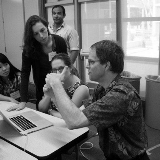About
Sterl Phinney is a theoretical astrophysicist.
His current research interests include astrophysical sources of gravitational radiation, gravitational wave detection from space and its future, pulsar physics, physics around black holes, and interactions of binary white dwarfs and neutron stars.
Awards
- Radboud Excellence Initiative Professor, 2015–16
- Fellow of the American Physical Society, 1996
- Warner Prize of the American Astronomical Society, 1995
- Alfred P. Sloan Foundation Research Fellowship, 1990
- Presidential Young Investigator, 1985
Relevant Publications
Kotera, K. et al. “Signatures of pulsars in the light curves of newly formed supernova remnants.” MNRAS 432 (July 2013): 3228–3236.
Milosavljevic, M., and E.S. Phinney. “The Afterglow of Massive Black Hole Coalescence.” Astrophys. J. Lett. 622 (2005): L93–L96.
Phinney, E.S. “Pulsars as Probes of Newtonian Dynamics.” Phil. Trans. Roy. Soc. Lond. A 341 (1992): 39–71.
Phinney, E.S. “The Rate of Neutron Star Binary Mergers in the Universe.” Astrophys. J. Lett. 380 (1991): L17–L21.
Rees, M.J. et al. “Ion-supported tori and the origin of radio jets.” Nature 295 (January 1982): 17–21.
